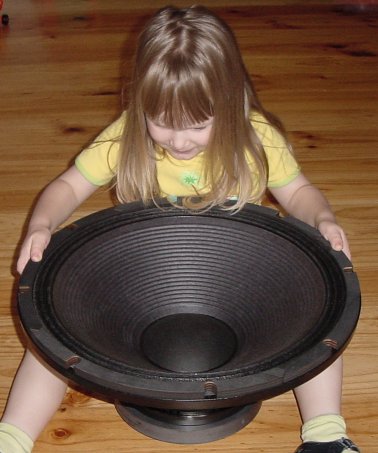"Bass, the final frontier." -- Thomas Danley
High quality sub-bass has a dramatic effect on the impact of a sound system. It adds a real sense of size and weight to the music, and gives it "body". I have often heard it said that there is no musical information below such and such, or "you can't hear that". A lot of people would be surprised just how much low frequency information exists on a well recorded disk. Very few people have experienced a sound system capable of reproducing 16Hz at high enough levels to be above the threshold of hearing. Real life often tickles your senses in the infrasonic region. The passing of a bus or the closing of a door has content down to almost 0Hz. It has been shown that the threshold of hearing at 3 HZ is about 120 dB and at 20 HZ the threshold of audibility is about 75 dB. It is true though that these very low frequencies can be felt long before they can be heard.
In my continuing hunt for the ultimate sub, I've run simulations on a large number of possible candidates. My design goal is to get the maximum output possible from 20Hz up, in an enclosure my family and I can live with. This usually limits me to two sub-bass enclosures each with a total volume of around 350 liters. I have 1200 Watts of drive into 8 Ohms available on each of two channels. Eq doesn't bother me so that can be used as necessary to flatten response. Very high displacement, low distortion and low power compression are all very important to me. Good output at 16Hz is also a must. You can never have too much bass, so here's a few more steps on my journey.
All of my previous sub-bass enclosures have been correctly tuned vented designs. Because of my size constraints and my desired F3, there is a theoretical maximum efficiency that can be achieved. All drivers I have modeled for sub-bass duty have almost the same efficiency at 20Hz in a 300 litre box. More can be read about this in "Closed-Box Loudspeaker Systems", published in the Journal of the Audio Engineering Society, Vol. 20 No. 10 (DEC 1972). Higher sensitivity is available above 30Hz or so with the Pro drivers , and this may be useful with some music. Before doing these simulations, I would not have guessed that very different drivers would be so close in sensitivity at 20Hz. In theory I knew this would be the case, but I didn't think they'd be within just a few dB in practice!
Given the size constraints in my listening room, I have regularly considered making the most the huge amount of ceiling space I have available. This could be well utilised by either installing an infinite baffle sub or a horn sub. I have designed both systems for use in my room, but haven't yet come to the point of building them and cutting a hole in my ceiling. Although the horn is very enticing, the most practical approach would have to be the infinite baffle arrangement. Construction is very simple, and the manifold which the drivers mount on to is easy to place in the loft.
Manifold infinite baffle subwoofers are particularly attractive for several reasons:
No subwoofer enclosure in the listening room.
Very high low frequency sensitivity.
Very low thermal compression.
High quality bass because of low Q design.
Simple enclosure design.
However, they have some drawbacks too:
Being sealed enclosures, more driver displacement is needed for a given output.
A suitable mounting location must be available to contain the back wave of the drivers.
A hole must be cut into the floor, ceiling or walls of the listening room for the manifold outlet.
Many people are quick to point out that an infinite baffle subwoofer has very low power handling. They fail to realise this is due to the very high sensitivity of the system. Since the driver does not have to fight against the air load in an enclosure, it can reach maximum output with very low input powers. This is a big advantage, as a smaller power amplifier can be used to provide exactly the same acoustic output from a given driver as would be achieved in a sealed enclosure with many times the amplifier power. This has the side effect of dramatically reducing thermal compression, and other dynamic nonlinearities in the driver's motor.
In Small's paper, Closed-Box Loudspeaker Systems, published in the Journal of the Audio Engineering Society Vol. 20 No. 10 (DEC 1972), he gives a formula for the maximum efficiency which can be obtained from sealed and vented enclosures at low frequencies.
For Sealed Boxes:
Efficiency (%) = 2 * 10-6 * f33 * VB
For Vented Boxes:
Efficiency (%) = 4 * 10-6 * f33 * VB
(f3 is in Hz, and VB is in cubic meters)
Here you can see that for a given F3, the low frequency efficiency is determined solely by the volume of the enclosure. (And limited by the driver of course) This shows the efficiency advantage that an infinite baffle loudspeaker has over a conventional sealed enclosure and even over the more sensitive vented enclosure.

Where the IB would live. This is the ceiling space above the listening room.

My big girl, Tahlia, checking out a high excursion 18" driver.
Back to my home page

